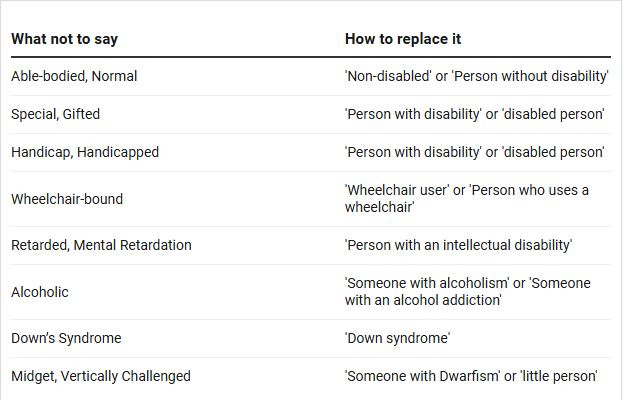What do “person-first” and “identity-first” mean?
Identity-first language describes someone by naming their disability as a central part of who they are. The disability usually comes first, suggesting it’s a key part of their identity:
A Blind person.
A Deaf person.
A Down syndrome boy.
A diabetic.
An Autistic girl.
A disabled person.
Person-first language puts the person before the disability, and the disability usually becomes a possessive of the person; it’s something they have:
A person with blindness.
A boy with Down syndrome.
A person with diabetes.
A girl with autism.
A person with disabilities.
Why are they important?
Different people have different preferences on how they’d like to be described.
This choice can be empowering — it allows people to indicate their relationship with their disability, and demonstrate how they interpret it relative to their identity. It provides space for them to be perceived on their own terms.
There is no global “right answer” on when to use person-first or identity-first language. Instead, you should rely on people to tell you what their preference is.
When is each used?
Many people prefer person-first language (a boy with Down syndrome), because it emphasizes their humanity first. It avoids defining their existence by their disability.
When I write, “My brother is a man with Down syndrome”, I’m implying that Down syndrome is but one of his characteristics, and that he lives a complex, full life, with many defining characteristics.
Down syndrome is something that he has, but it is not what he is. He’s Jonnie, and there’s a lot more to Jonnie than an extra chromosome.
Other people prefer identity-first language. You see this more commonly in the Autism, Blind, and Deaf communities. Some folks feel an extreme sense of pride to be a part of their community, and they choose to be identified by that community (i.e., an autistic girl, as opposed to a girl with autism).
For example, the National Association of the Deaf supports the identity-first approach.
Others who choose identity-first language believe that their identity is inextricably linked to their disability. A person with blindness might prefer to be referred to as a “Blind person” because blindness intersects with almost everything they experience, and therefore should be front and center to help others understand how impactful and potentially debilitating the disability can be. It’s not just what they have, it’s a piece of who they are.
At times, I do find myself referring to my brother as a “disabled adult” (identity-first language) in situations where it’s important the other party understands the limitations his disability can cause (usually over the phone with a medical provider, medical supplier, or government agency). I think I do this subconsciously to avoid the awkward questions that inevitably accompany being my brother’s guardian.
What should you do?
Just ask.
“Do you use person-first or identity-first language?”
There is no consensus in addressing someone’s disability, and it’s easy to make an incorrect assumption.
The only mistake you can make is knowingly using the wrong language.
If the person cannot express to you which language they identify with, default to person-first language, as that is broadly accepted as respectful for those who cannot tell you their preference themselves.
This is why I use person-first language with my brother.
What not to say, and what to replace it with:

The examples above are a loose guide, and not applicable in all situations. If you’re looking for more specific information, I’d recommend you check out the National Center on Disability and Journalism’s guide.
Ultimately, the best thing is simply to ask the person about their preference.
The information in this guide is likely to change with time. Community norms evolve; that’s what progress looks like.
Language preferences are not an arbitrary moving target — they’re the culmination of collective communities coming together and speaking up in meaningful ways.
Let’s listen.
What’s next?
Next week, I’ll have an update on the piece of legislation making its way through Congress. You can read my first post about it here.
What can you do?
If this writing or our story helped you, click the subscribe button; it’s free. It enables you to receive future posts emailed to you directly as soon as they’re released. Also, consider sharing this story with someone close to you.
Want to connect or give some feedback? Drop Joe an email here.





I learned this lesson the hard way in 1988. I started working in Personnel at Oak Hill after working seven years in direct care and as a group home manager. I put an advertisement in the Hartford Courant for, “Staff needed to work with blind individuals.” My supervisor told me that I should have worded it, “Staff needed to work with individuals who have visual impairment.” She discussed what your writing explained in a gentle way as she could see my distress in making this mistake.